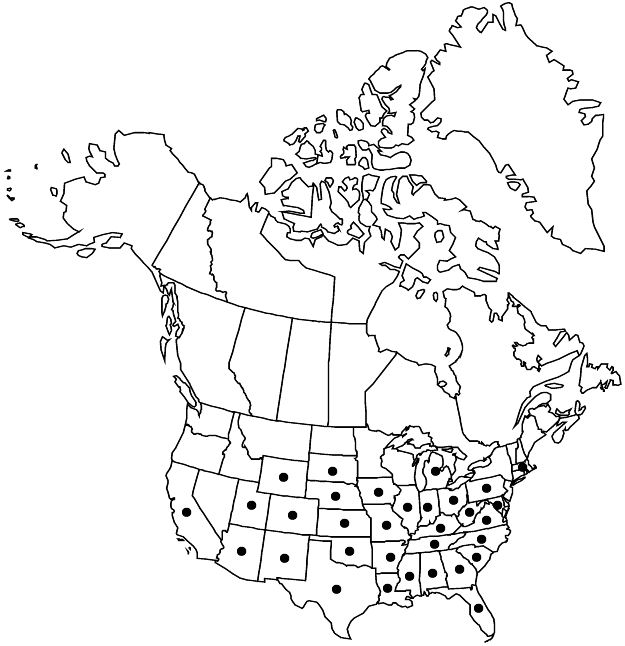Euphorbia prostrata
Hort. Kew. 2: 139. 1789.
Herbs, annual, with taproot. Stems prostrate to decumbent, usually not mat-forming, 10–30 cm, crisped-villous to glabrate (proximally). Leaves opposite; stipules connate (lower side) or distinct (upper side), triangular-subulate, often lacerate distally, 0.5–1 mm, short crisped-villous to glabrate; petiole 0.5–1.5 mm, usually short crisped-villous, sometimes wooly at distal nodes; blade broadly elliptic to elliptic-oblong, ovate-spatulate, or ovate, 3–11(–15) × 3–6(–8) mm, base slightly asymmetric, rounded to slightly cordate and oblique, margins serrulate at least in distal 1/2, sometimes obscurely so, apex obtuse, abaxial surface finely crisped-villous, adaxial surface usually glabrous or glabrate, sometimes sparsely crisped-villous; 3-veined from base. Cyathia solitary or in small, cymose clusters at distal nodes or on congested, axillary branches; peduncle 1–2 mm. Involucre obconic, 0.6–0.9 × 0.5 mm, crisped-villous or glabrous; glands 4, reddish, oval to oblong, 0.1 × 0.1–0.2 mm; appendages white to pink, rudimentary, 0–0.2 mm, distal margin entire or irregularly scalloped. Staminate flowers 3–6. Pistillate flowers: ovary densely crisped-villous; styles 0.1 mm, 2-fid nearly entire length. Capsules broadly ovoid, 1.2–2 × 1.4–1.5 mm, crisped-villous along keels and toward base, often glabrous between keels; columella 1–1.2 mm. Seeds white but with barely concealed brown surface beneath, ovoid, sharply 4-angled in cross section, abaxial faces plane to convex, adaxial faces concave, 0.8–1.1 × 0.5–0.7 mm, with several narrow, sharp, slightly irregular, transverse ridges. 2n = 18.
Phenology: Flowering and fruiting early spring–fall.
Habitat: Disturbed areas, fields, gardens, sidewalks, sandy places, ballast piles.
Elevation: 0–1400 m.
Distribution

Ala., Ariz., Ark., Calif., Colo., Fla., Ga., Ill., Ind., Iowa, Kans., Ky., La., Md., Mass., Mich., Miss., Mo., Nebr., N.Mex., N.C., Ohio, Okla., Pa., S.C., S.Dak., Tenn., Tex., Utah, Va., W.Va., Wyo., Mexico, West Indies, Central America, South America, introduced in Eurasia, Africa, Pacific Islands, Australia.
Discussion
Euphorbia prostrata is native to tropical America and possibly into the southern part of the flora area. It is likely adventive throughout most of the northern part of its range. It is widely naturalized throughout much of the rest of the tropics.
Selected References
None.